Wish I'd read 'em in this order.
Seaguy: Slaves of Mickey Eye #3 (of 3)
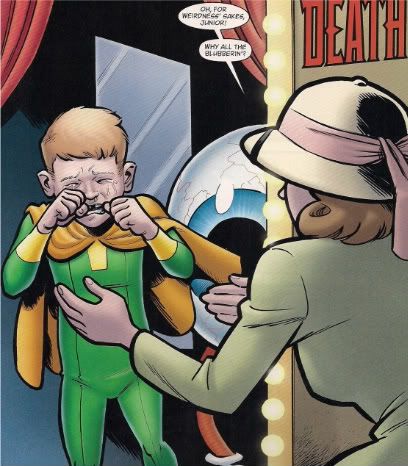
I know my mind is broken and all, but isn't that one hell of a Chris Ware pose Mom is striking up there? Jesus Christ I love that.
Last time around, reader Moose N. Squirrel suggested I wasn't doing this series justice with my continued focus on its inherent superhero genre critique. And I agree, it's definitely about more than that. At its broadest, the extended Seaguy saga is about becoming aware of the controlling forces of this world -- in place before you can think, and adept at doing the subsequent thinking for you -- and taking it upon yourself to become aware of the contours of that control. Stability, comfort, amusement - it's all part of the plan.
So pretend its a wall. You come to understand its size, and you push. It moves a little, maybe gives a ways before you have to back up. Writer Grant Morrison has suggested the Seaguy books each represent a period in the title character's growth, and for now that's fitting. A child pushes a little ways, in Book 1, then falls over and goes back to bed. A teenager, in the present book, pushes and pushes with intent to wreck. But those kids are callow, and rarely make sure the job's done right. Around their romance, the mechanisms still click.
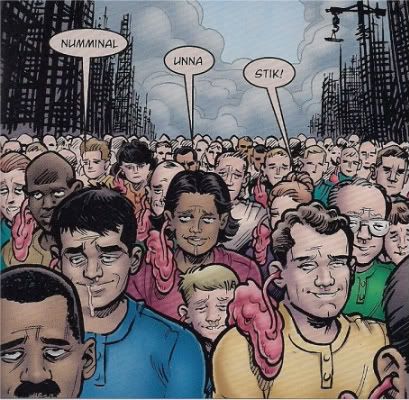
On the other hand, there's another part of this issue I love to pieces, the very last page, and while it's a decent enough grace note on its own, you really don't get the full impact unless: (A) you've read New X-Men; (B) you're aware of the proximity of the original Seaguy's release to a troubled genre situation at Marvel; and (C) you recognize how the in-story idealism of the older work applies to the commentary-on-the-refutation-of-that-idealism of Seaguy by again becoming in-story idealism.
It's very teenage, very fuck you I do believe in change FUCK YOU, and while Morrison's intertextual frolics and rampant cross-referencing and calling back can become overwhelming, this is one of the times where it's done to heartbreakingly lovely effect, one that relies on the superhero aspect of the greater metaphor.
Indeed, even on a page-by-page basis, the comic is stronger when it's close to the viscerally fantastic; Cameron Stewart has ample opportunity to flex his whimsey-terror muscles in a great bit with Mickey Eye costumed characters dragging citizens of its magic kingdom into a factory-dungeon for granting wishes made through tears -- those big eyes and their red legs and little tails look cute even dumping bodies in the furnace -- while a later bit taking on reality television and consumer video narcissism feels like mere lecturing despite its larger social topic. Plus, the big climactic superhero fights has one of the best laughs of the series ("ikt"), although I liked the bit with the wedding invitation too.
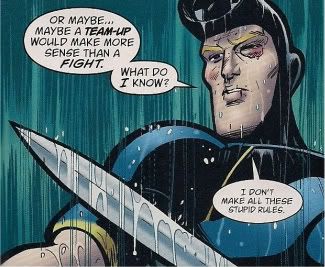
There's some curious storytelling choices, though, which maybe serve to shore up the metaphor better than the drama. The Seaguy we see in this issue seems a good five or six steps farther along the path than the just-again-waking guy we left in issue #2; Morrison even inserts some dialogue alluding to terrible things the hero as seen to change him, although not in any specific way. Whatever it is, he's ready and able to rip the place down, although ambiguity hasn't been totally abandoned; like in The Prisoner, the nonconformist's victory over Number 2 only reveals more of the workings of the Village, and Seaguy doesn't even go so far as to ask to see Number 1.
It's enough that there's a hole in the wall, even as he's told a New Eye is as good as grown. No matter; the series plunges back into metaphor. The eternal swordfight, the long struggle, fighting and fighting to get at what you want, endless struggle; last issue has Seaguy reject absurd masculine extremes and this one sees everyone halt the violence, save for in the service of revolution! If this is Western society, it's awfully self-healing, being the best there is at what it does (and what it does is sustain itself). And if its superheroes, isn't this little victory just a request for now that everything not be so ugly and retroactive? Like, don't do anything really awful?
I guess the future form is left to Book 3; Morrison's present tense seems pronounced simply enough.
***
Batman and Robin #1
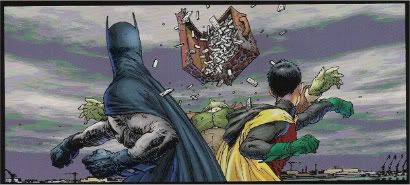
Case in point. Morrison has mentioned that this series is going to be a forum for "just crazy stories that are pretty upfront," as opposed to, say, R.I.P., and while this sort of anticipatory pronouncement needn't and shouldn't be taken as a warranty -- I'm pretty sure Seven Soldiers was preceded with an ultimately (happily) broken vow to leave his metaphors in the drawer -- so far, this time, I actually believe him.
Quite frankly, I don't have all that much to say about this comic. It's a slick, enjoyable introduction to the new Batman status quo, entirely accessible to anyone who skipped Battle for the Cowl (say, me), though still unobtrusively connected to prior Morrison storylines; note that gooey, ham-headed villain Prof. Pyg (a possible university colleague to Dr. Hurt?) is the same guy that enjoys an inverted crucifixion in Batman #666's alternate future. And what better way to kick off a breezy new series -- one that sees fit to open with Our Heroes putting a stop to Mr. Toad's wild ride... of crime!! -- than a quick citation to one of the best issues of the prior run, one dedicated to showing off how bad it all could be if the Batman were goddamned different.
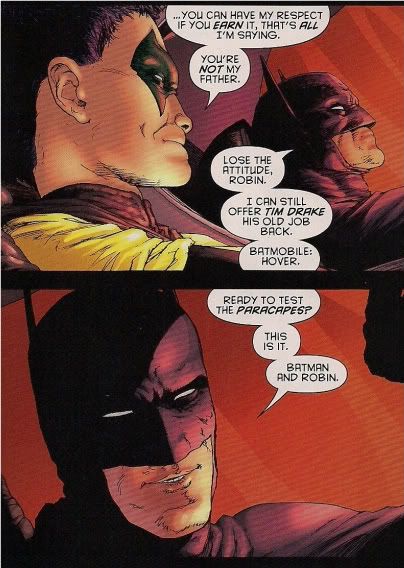
Frank Quitely, though, does deserve a few words. I hate to be the 10,000th mention of this on the internet, but Morrison's particular approach to storytelling compression really does come off a lot better accompanied by an artist that carries a unique cut of the burden.
The script here doesn't get into the details of how Dick Grayson took up the Batman position at all, nor does it spend any time detailing his connection to Damian. It does provide a few pages of angst for Dick, and several dismissive remarks from his boy sidekick -- already one of the funnier ideas at work is having a Batman teamed with a Robin that's really, really, really eager to move up the Bat-hierarchy -- yet the art gently leavens the tone with Dick's slight smile, and Damion's relaxed posture; there's real camaraderie here, silent but authentic, bonding this super young team as eager to get some things done, high-profile. Words can't do that alone.
I suspect comparisons to All Star Superman are inevitable; on a purely visual level, Quitely seems slightly scratchier with his pencils, maybe as a consequence of working with a different colorist (Alex Sinclar, Gotham dark & busy to Jamie Grant's Metropolis bright 'n shiny), or possibly due to cutting loose the Super-series' airy wide views in favor of heavier action. Morrison, meanwhile, seems especially dedicated to serving up a fresh start, which is appropriate beyond the issue number on the cover. Both ASS and the former Batman strove to provide comprehensive visions of their respective heroes, the former through distillation, and the latter via accumulation, accepting all of Bat-history as 'true.'
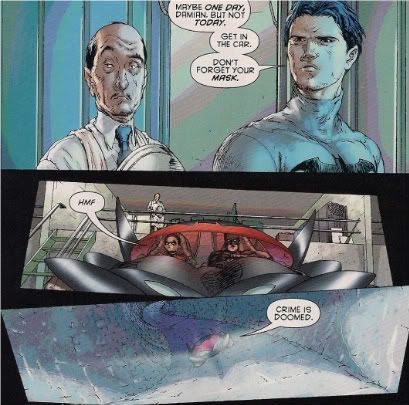
That's all over now, and while Batman and Robin has several things in common with the Superman book -- an old-yet-new cast, a 12-issue megastory, a light-yet-serious feel, Frank Quitely (for now) -- it's also an in-continuity advance toward simpler, sleeker Batman comics. Funny that the out-of-continuity ASS could just pick up and be, while the DCU material apparently needed a lengthy exegesis and a crossover Event and the replacement of the characters wearing the costumes to roll its way to the point of being a pick-up-and-go friendly superhero comic.
Which is exactly what this is for the moment: a fun, accessible Batman book with neat takes on the main cast and some colorful new(ish) villains, no more, no less. It's not built to last; Quitely will be absent for issues #4-9, in favor of different art teams, and obviously we can expect Bruce Wayne's return sometime after #12, if not earlier. Hell, Final Crisis itself made it clear he wouldn't stay dead.
The object then, I think, is to get a little extra fun in while that possibility is least encumbered, and maybe serve as an example for the more exacting rebirth of the first guy. Small steps, pressing toward the barricade. Like the guy in the wetsuit.

I know my mind is broken and all, but isn't that one hell of a Chris Ware pose Mom is striking up there? Jesus Christ I love that.
Last time around, reader Moose N. Squirrel suggested I wasn't doing this series justice with my continued focus on its inherent superhero genre critique. And I agree, it's definitely about more than that. At its broadest, the extended Seaguy saga is about becoming aware of the controlling forces of this world -- in place before you can think, and adept at doing the subsequent thinking for you -- and taking it upon yourself to become aware of the contours of that control. Stability, comfort, amusement - it's all part of the plan.
So pretend its a wall. You come to understand its size, and you push. It moves a little, maybe gives a ways before you have to back up. Writer Grant Morrison has suggested the Seaguy books each represent a period in the title character's growth, and for now that's fitting. A child pushes a little ways, in Book 1, then falls over and goes back to bed. A teenager, in the present book, pushes and pushes with intent to wreck. But those kids are callow, and rarely make sure the job's done right. Around their romance, the mechanisms still click.

On the other hand, there's another part of this issue I love to pieces, the very last page, and while it's a decent enough grace note on its own, you really don't get the full impact unless: (A) you've read New X-Men; (B) you're aware of the proximity of the original Seaguy's release to a troubled genre situation at Marvel; and (C) you recognize how the in-story idealism of the older work applies to the commentary-on-the-refutation-of-that-idealism of Seaguy by again becoming in-story idealism.
It's very teenage, very fuck you I do believe in change FUCK YOU, and while Morrison's intertextual frolics and rampant cross-referencing and calling back can become overwhelming, this is one of the times where it's done to heartbreakingly lovely effect, one that relies on the superhero aspect of the greater metaphor.
Indeed, even on a page-by-page basis, the comic is stronger when it's close to the viscerally fantastic; Cameron Stewart has ample opportunity to flex his whimsey-terror muscles in a great bit with Mickey Eye costumed characters dragging citizens of its magic kingdom into a factory-dungeon for granting wishes made through tears -- those big eyes and their red legs and little tails look cute even dumping bodies in the furnace -- while a later bit taking on reality television and consumer video narcissism feels like mere lecturing despite its larger social topic. Plus, the big climactic superhero fights has one of the best laughs of the series ("ikt"), although I liked the bit with the wedding invitation too.

There's some curious storytelling choices, though, which maybe serve to shore up the metaphor better than the drama. The Seaguy we see in this issue seems a good five or six steps farther along the path than the just-again-waking guy we left in issue #2; Morrison even inserts some dialogue alluding to terrible things the hero as seen to change him, although not in any specific way. Whatever it is, he's ready and able to rip the place down, although ambiguity hasn't been totally abandoned; like in The Prisoner, the nonconformist's victory over Number 2 only reveals more of the workings of the Village, and Seaguy doesn't even go so far as to ask to see Number 1.
It's enough that there's a hole in the wall, even as he's told a New Eye is as good as grown. No matter; the series plunges back into metaphor. The eternal swordfight, the long struggle, fighting and fighting to get at what you want, endless struggle; last issue has Seaguy reject absurd masculine extremes and this one sees everyone halt the violence, save for in the service of revolution! If this is Western society, it's awfully self-healing, being the best there is at what it does (and what it does is sustain itself). And if its superheroes, isn't this little victory just a request for now that everything not be so ugly and retroactive? Like, don't do anything really awful?
I guess the future form is left to Book 3; Morrison's present tense seems pronounced simply enough.
***
Batman and Robin #1

Case in point. Morrison has mentioned that this series is going to be a forum for "just crazy stories that are pretty upfront," as opposed to, say, R.I.P., and while this sort of anticipatory pronouncement needn't and shouldn't be taken as a warranty -- I'm pretty sure Seven Soldiers was preceded with an ultimately (happily) broken vow to leave his metaphors in the drawer -- so far, this time, I actually believe him.
Quite frankly, I don't have all that much to say about this comic. It's a slick, enjoyable introduction to the new Batman status quo, entirely accessible to anyone who skipped Battle for the Cowl (say, me), though still unobtrusively connected to prior Morrison storylines; note that gooey, ham-headed villain Prof. Pyg (a possible university colleague to Dr. Hurt?) is the same guy that enjoys an inverted crucifixion in Batman #666's alternate future. And what better way to kick off a breezy new series -- one that sees fit to open with Our Heroes putting a stop to Mr. Toad's wild ride... of crime!! -- than a quick citation to one of the best issues of the prior run, one dedicated to showing off how bad it all could be if the Batman were goddamned different.

Frank Quitely, though, does deserve a few words. I hate to be the 10,000th mention of this on the internet, but Morrison's particular approach to storytelling compression really does come off a lot better accompanied by an artist that carries a unique cut of the burden.
The script here doesn't get into the details of how Dick Grayson took up the Batman position at all, nor does it spend any time detailing his connection to Damian. It does provide a few pages of angst for Dick, and several dismissive remarks from his boy sidekick -- already one of the funnier ideas at work is having a Batman teamed with a Robin that's really, really, really eager to move up the Bat-hierarchy -- yet the art gently leavens the tone with Dick's slight smile, and Damion's relaxed posture; there's real camaraderie here, silent but authentic, bonding this super young team as eager to get some things done, high-profile. Words can't do that alone.
I suspect comparisons to All Star Superman are inevitable; on a purely visual level, Quitely seems slightly scratchier with his pencils, maybe as a consequence of working with a different colorist (Alex Sinclar, Gotham dark & busy to Jamie Grant's Metropolis bright 'n shiny), or possibly due to cutting loose the Super-series' airy wide views in favor of heavier action. Morrison, meanwhile, seems especially dedicated to serving up a fresh start, which is appropriate beyond the issue number on the cover. Both ASS and the former Batman strove to provide comprehensive visions of their respective heroes, the former through distillation, and the latter via accumulation, accepting all of Bat-history as 'true.'

That's all over now, and while Batman and Robin has several things in common with the Superman book -- an old-yet-new cast, a 12-issue megastory, a light-yet-serious feel, Frank Quitely (for now) -- it's also an in-continuity advance toward simpler, sleeker Batman comics. Funny that the out-of-continuity ASS could just pick up and be, while the DCU material apparently needed a lengthy exegesis and a crossover Event and the replacement of the characters wearing the costumes to roll its way to the point of being a pick-up-and-go friendly superhero comic.
Which is exactly what this is for the moment: a fun, accessible Batman book with neat takes on the main cast and some colorful new(ish) villains, no more, no less. It's not built to last; Quitely will be absent for issues #4-9, in favor of different art teams, and obviously we can expect Bruce Wayne's return sometime after #12, if not earlier. Hell, Final Crisis itself made it clear he wouldn't stay dead.
The object then, I think, is to get a little extra fun in while that possibility is least encumbered, and maybe serve as an example for the more exacting rebirth of the first guy. Small steps, pressing toward the barricade. Like the guy in the wetsuit.

<< Home